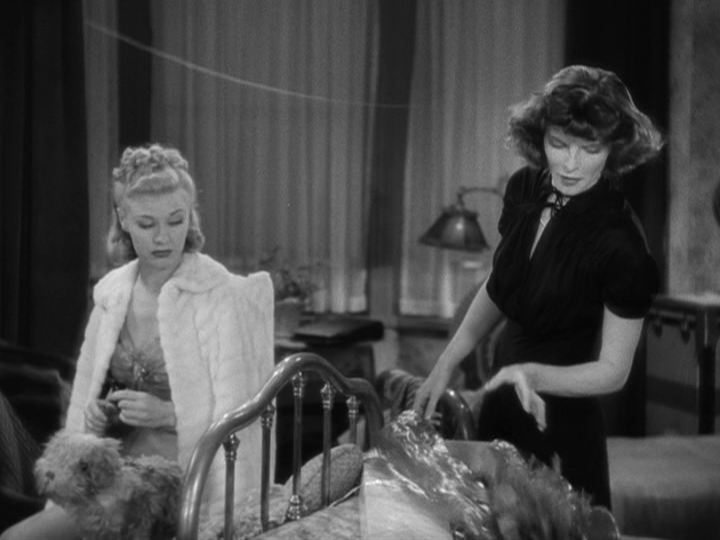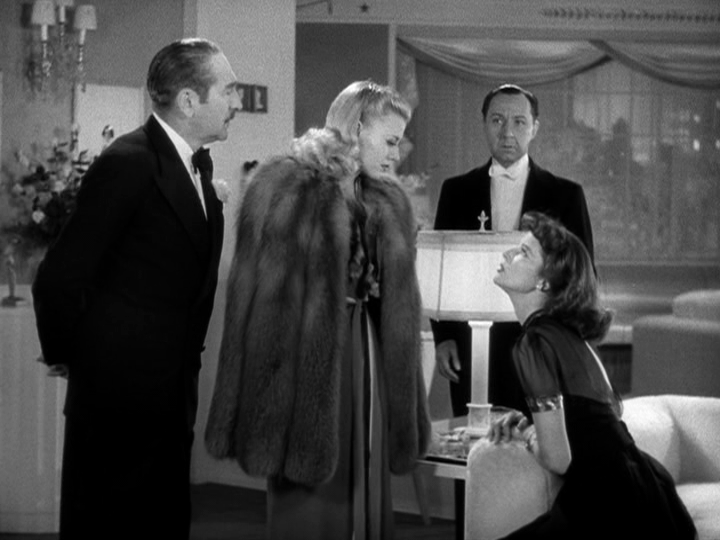Stage Door, 1937, RKO Radio Pictures. Starring Katharine Hepburn, Ginger Rogers, Adolphe Menjou. Directed by Gregory La Cava. B&W, 92 minutes.
Wealthy society girl Terry Randall yearns to make it on Broadway, and she’s willing to live humbly if that’s the road to getting her name in lights. She rents a room at the Footlights theatrical boarding house, where all the young women are seeking their big break. Those women take one look at Terry and roll their eyes at her upper-crust ways, while Jean Maitland (Ginger Rogers), her new roommate, checks out Terry’s wardrobe and sees a clear picture—Terry has a sugar daddy.
In a manner of speaking, she does. Unbeknownst to Terry, her father has arranged for her to star in powerful Broadway producer Tony Powell’s (Adolphe Menjou) next major production. For his part, Powell has an eye for young ladies, and while he is somewhat dedicated to Linda Shaw (Gail Patrick), he’ll set her aside from time to time for a fresh face, as he soon does with Jean.
Terry’s success means failure for last year’s golden girl, Kay Hamilton (Andrea Leeds), who is fragile, broke and out of work. Ultimately, the fate of one will mean the demise of the other.

Ginger Rogers, Katharine Hepburn
The film also features then little-known actresses who would go on to great success, such as Lucille Ball, Ann Miller and Eve Arden. Miller dances with Rogers in one scene, and seeing the two side-by-side is an interesting peek at their notably different dance styles. Ball, by the way, is not yet a redhead, and those familiar with Arden will recognize her distinctive voice before she appears onscreen.
Hepburn was a lesser-known actress at the time, and this film helped establish her with audiences. Like her character, Hepburn took an intellectual approach to acting, and was from upper-class society. The part seemed to have been written for her.
She and Rogers did not get along during filming, something director La Cava took full advantage of in developing their characters. Rogers was one of the most popular actresses of the year when Stage Door was released, while Hepburn was barely recognized. Hepburn fought for, and got, top billing, as well as the dominant role. It did little to endear her to her co-star.

Lucille Ball, Ginger Rogers
Hepburn incorporated lines from a previous role in the rehearsal scenes, in particular, a performance in The Lake of which Dorothy Parker had caustically written, “Her emotions ran the gamut from A to B.” However poorly she may have previously handled those lines, in Stage Door, she ultimately achieves success with them.
The film received four Academy Award nominations: Best Picture, Best Director, Best Supporting Actress (Leeds) and Best Screenplay Adaptation. It won none. It was well-received by critics, but didn’t fare as well as with audiences, and was only a modest success.
Stage Door is a well-directed story with a smooth script and capable stars, as well as a strong supporting cast (as evidenced by their later successes). It adeptly manages the restrictions of the Production Code, well in force by this time, bringing the edgy lifestyles of the characters portrayed to life in a realistic manner. Fans of both Rogers and Hepburn will like what they find here.

Adolphe Menjou, Ginger Rogers, Franklin Pangborn, Katharine Hepburn

As I always do…learned new things from your wonderful post! Thank you, Belinda!
LikeLiked by 1 person
Thank you!
LikeLike
My personal favourite from 1937 🙂
LikeLiked by 1 person
It has a lot of treasure in its performances!
LikeLike
Great post – I also wanted to say that this blog looks great. Up until now I’ve been reading it on my phone, but now I’m getting the full picture. The header in particular is so perfect.
LikeLiked by 1 person
Thank you so much! I’m not sure which header you saw — I have three that rotate, but they’re very similar.
LikeLike
The director’s chair.
LikeLiked by 1 person
That’s my favorite.
LikeLiked by 1 person